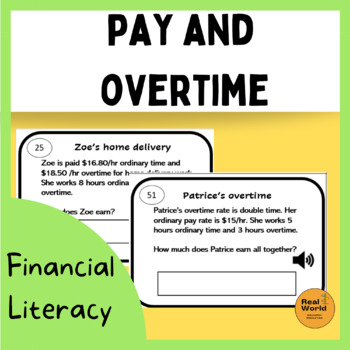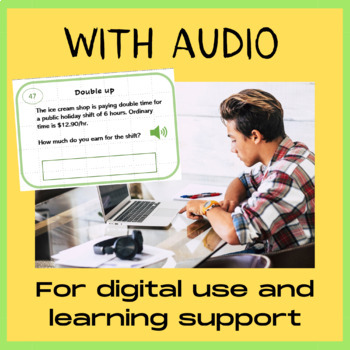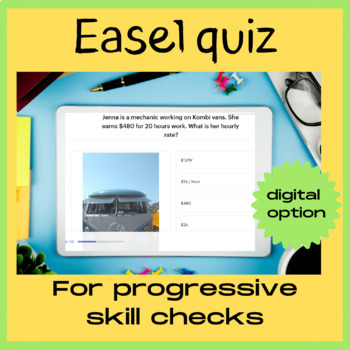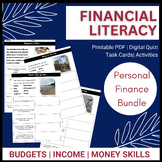Financial literacy rates of pay and overtime task cards and digital quiz
- Zip
- Easel Assessment
Also included in
- Your students will love using this financial literacy bundle to practice money skills for shopping, budgeting and saving. These engaging life skills math printables are perfect for life skills, transition and special education high school students who are learning about personal finances. With printPrice $18.16Original Price $25.95Save $7.79
Description
Your Consumer and Financial Maths, Life Skills, VCAL and Transition Education students will love using these new editable financial literacy rates of pay and overtime task cards to build their personal finance skills as part of being ready for work. Use the print or digital pay rates and overtime task cards as part of a math center, co-operative learning activity or during a remote learning phase (using the digital option with embedded audio or the digital Easel progress checker quiz).
Set Two - Overtime rates, rates of pay, pay cycles, total pay
Set Two contains 28 task cards numbered 25-52. Each task card is designed to support financial literacy and work readiness for teens and young adults through thinking, planning and solving problems. The cards model typical financial algebra calculations that are needed for working with rates of pay, hours worked, total pay, ordinary and bonus pay rates, variable hours and timesheet errors.
Assumed knowledge and skills for Set Two is:
•Use of a calculator for calculations and checking answers as needed
•Understanding of hourly rate, total income and hours worked
•Understanding rosters and timesheets
•Understanding of ordinary time, time and a half, double time and triple time
•Ability to work with whole and half dollar amounts
•Ability to work with whole and part hours
•Ability to complete one, two and three step calculations
This set uses the following skills::
•Reading worded problems
•Calculating total pay from ordinary and bonus hourly rates and number of hours worked
•Calculating hourly rate from total pay and number of hours worked
•Calculating hours worked from total pay and hourly rate
•Adding hours worked on multiple days or shifts to find total hours
•Checking payments and working with timesheet errors
Here's how...
Print the cards for in class use. Share them with individuals, pairs or small groups. Allow time for solving the card, then swap and compare answers. Check work against the answer key.
Use the cards as a digital version in PPT to access the audio for each task card. This is a great option for remote learning and to provide audio support for learners as needed.
Use the digital Easel assessment as a pre-test, progress checker or a formative assessment at the end of the topic.
Fundamental skills and knowledge...
•Reading worded problems
•Calculating total pay from an hourly rate and number of hours worked
•Calculating hourly rate from total pay and number of hours worked
•Calculating hours worked from total pay and hourly rate
•Adding hours worked on multiple days or shifts to find total hours
Examples
Trixi loves her café job! She works 7-10 pm for 3 days per week at a rate of $28.56/hr and one double time cleaning shift per month from 5-9 pm on a Friday night.
What does Trixi earn in one month?
The ice cream shop is paying double time for a public holiday shift of 6 hours. Ordinary time is $12.90/hr.
How much do you earn for the shift?
Terms of use
Please enjoy using these financial literacy rates of pay and overtime task cards with your own students in your class or group, or across your own set of students. You may modify the font size, style and colour to support the learning needs of individual students as required.
COMMUNITY SKILLS
FREE to download and use with your class.
Learn how to be safe in and around water, and how to respond to an emergency. For older readers with developing reading skills.
Community problem solving task cards
Read the task card, discuss the scenario, find the best solution
Community signs matching cards
Match the community sign with its meaning
Community signs activities and printables for visual literacy
Build visual literacy skills and understanding of signs found in the community with these printable cards and activity pages
Learn to use a modified map to find places in the community, use a simple grid reference or match text with images and symbols
Begin to plan and organize a routine and develop independent learning skills by using calendars and schedules.
Find out how to stay safe during kitchen cooking activities with the true / false digital quiz.
LITERACY SKILLS
A print and go comprehensive literacy book written for teens and young adults with lower literacy skills
An easy reading passage with questions about the festival of Diwali.
Functional reading skills with instructions and labels
Build functional reading skills with these print and go worksheets about instructions and labels in everyday life.
NUMERACY SKILLS
Real World Maths Ebook for Life Skills
A life skills math book with a focus on practical, everyday numeracy activities for teens and young adults.
A huge collection of print and digital math resources, all carefully designed to meet the needs of older students with lower math skills who prefer easy reading text and modified activities.
Use the full colour task cards to compare the mass of fruits and vegetables using grams and kilograms
STAY IN TOUCH
Visit our Anne Vize Writing FB page to learn about new teaching ideas, resources and tips!
Read about literacy and text types for teens with this new article.
Follow our TpT store to learn what's new in inclusive and vocational education for teens.
ABOUT THE AUTHOR
Anne Vize is a special education teacher and writer from Australia. She is the author of over 30 books published for educators, including these Essential Resources titles:
The A to Z of Special Needs (2nd edition)- what you need to know about working with children who have additional learning needs
Including all children - strategies that work - best practice approaches to working with children who have a disability in an education or childcare setting
Taking Care of You - learning to manage stress and reduce burnout for educators
Inclusive Outdoor Play - discover how to adapt an outdoor play space or activity so it is accessible and positive for all children







